Parveen Bala, a member of the Standing Committee on Social Affairs, has called for a formal report from Fiji National University (FNU) following the Ministry of Infrastructure’s recommendation to demolish the incomplete Naiyaca campus in Labasa. Concerns were expressed during a recent committee visit to the site, particularly regarding the university’s infrastructural plans and the allocation of government funds.
Acting Deputy Director of Capital at FNU, Merewalesi Naikatini, emphasized that the university has sought guidance from the Ministry concerning the future of the campus. FNU Vice-Chancellor Professor Unaisi Nabobo-Baba noted that while certain structures are deemed safe, others present significant safety risks and have been restricted from use. She also mentioned the heavy financial burden of renting multiple educational facilities, expressing a preference to resume construction at the Naiyaca site.
In light of the committee’s questions, a request has been made for all pertinent structural and engineering assessments to ensure transparency regarding the expenditure of public funds in the $30 million project, which began preliminary work in 2014. Full construction was initiated in 2018, but work was suspended in 2019.
Education Minister Aseri Radrodro mentioned in a recent parliamentary session that a structural review deemed the building unsafe, prompting the recommendation for its demolition. This situation has led to a reported impairment loss of approximately $9.9 million, alongside an additional $4.3 million attributed to capitalized civil works that remain incomplete.
Historical accounts of the Naiyaca Campus project highlight a series of challenges, including significant delays due to its flood-prone location and issues with contractor finances. Despite these hurdles, there is a sense of optimism that improved governance and oversight could pave the way for the Naiyaca Campus to enhance educational opportunities in the Northern Division, thus benefitting the local community. The ongoing commitment to infrastructure development suggests that a brighter future for education in the region may be on the horizon, even in the face of current difficulties.
